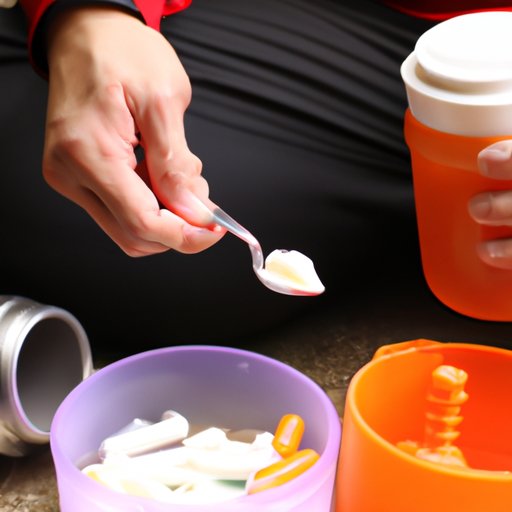I. Introduction
Muscle loss is a common issue that many people face during weight loss or when they reduce their physical activity levels. Losing muscle mass can impact our overall physical health, as muscles are responsible for movement, strength and stability in our body. Understanding how long it takes to lose muscle can help us take the necessary steps to avoid muscle loss, or if it does occur, to regain the lost muscle mass. This article will explore the science behind muscle loss, tips and strategies for minimizing muscle loss, the role of nutrition in muscle preservation, and how to regain lost muscle mass.
II. The Science behind Muscle Loss
The amount of time it takes to lose muscle mass can depend on a number of factors such as age, genetics, gender, exercise habits, and nutritional intake.
- Age: As we age, our muscle mass tends to decrease, and the rate of muscle loss increases.
- Genetics: Some people may be genetically predisposed to lose or gain muscle mass more easily than others.
- Gender: Men tend to have more muscle mass than women due to differences in testosterone levels.
- Exercise habits: A decrease in physical activity levels can lead to muscle loss.
- Nutritional intake: Poor nutrition, especially a lack of protein intake, can contribute to muscle loss.
The physiological mechanisms that occur during muscle loss include protein breakdown, muscle fiber size reduction, and mitochondrial dysfunction.
III. Avoiding Muscle Loss during Weight Loss
When losing weight, it’s important to preserve muscle mass to maintain our strength, mobility, and overall health. Here are some tips and strategies for minimizing muscle loss:
- Resistance training: Incorporating resistance training into your exercise routine can help maintain muscle mass. Resistance training can include exercises such as weightlifting, push-ups, and squats.
- Incorporating protein-rich foods in meals: Consuming protein-rich foods such as eggs, lean meats, and legumes can help preserve muscle mass.
- Proper hydration: Staying properly hydrated can help maintain muscle function and prevent muscle cramps and fatigue.
- Increased calorie intake: Reducing calorie intake too drastically can lead to muscle loss. Finding a balance between calorie reduction and maintaining adequate nutrition can help reduce muscle loss.
IV. The Role of Nutrition in Muscle Preservation
Protein is important for preserving muscle mass as it is the main building block of muscle tissue. The recommended daily intake of protein to maintain muscle mass ranges from 1.2-1.6 grams per kilogram of body weight.
- How much protein is needed to maintain muscle mass? The amount of protein needed to maintain muscle mass can vary depending on a person’s age, gender and physical activity level.
- Sources of protein: Consuming a variety of protein-rich foods such as eggs, lean meats, dairy products, nuts, and legumes can help meet daily protein requirements.
Other nutrients that support muscle health include vitamin D and omega-3 fatty acids. Vitamin D helps with muscle function, while omega-3 fatty acids can help reduce inflammation, which can contribute to muscle loss.
V. Common Mistakes that Lead to Muscle Loss
There are some common mistakes that people make that can speed up muscle loss:
- Cardio-heavy workout routines: Too much cardio without resistance training can contribute to muscle loss.
- Not enough rest and recovery time: Adequate rest and recovery time is crucial for allowing muscles to repair and grow.
- Limiting calorie intake too much: Rapid weight loss or reducing calorie intake too drastically can contribute to muscle loss.
- Sedentary lifestyle: A lack of physical activity can lead to muscle loss.
Avoiding these mistakes involves incorporating resistance training into your workout routine, allowing for adequate rest and recovery time, finding a balance between calorie reduction and maintaining proper nutrition, and increasing physical activity levels.
VI. Regaining Lost Muscle
If muscle loss does occur, it is possible to rebuild muscle mass through resistance training and proper nutrition. Here are some tips:
- Resistance training: Incorporating resistance training into your workout routine can help rebuild muscle mass.
- Proper nutrition: Consuming enough protein and overall calories to support muscle growth is important.
- Adequate rest and recovery: Allowing for adequate rest and recovery time is important for muscle growth.
Maintaining muscle mass moving forward involves incorporating resistance training into your exercise routine, consuming enough protein and overall calories to support muscle growth, and regular fitness evaluations to track progress and adjust your routine as needed.
VII. Conclusion
Muscle loss can impact our overall physical health, but it is possible to minimize or prevent muscle loss through proper exercise and nutrition. Incorporating resistance training and protein-rich foods into our routines can help preserve muscle mass during weight loss. Avoiding common mistakes such as limiting calorie intake too much and not allowing for adequate rest and recovery time can also help prevent muscle loss. If muscle loss does occur, it is possible to regain lost muscle mass through resistance training, proper nutrition, and rest and recovery time.
Take the necessary steps to maintain and preserve your muscle mass for a strong and healthy body.
